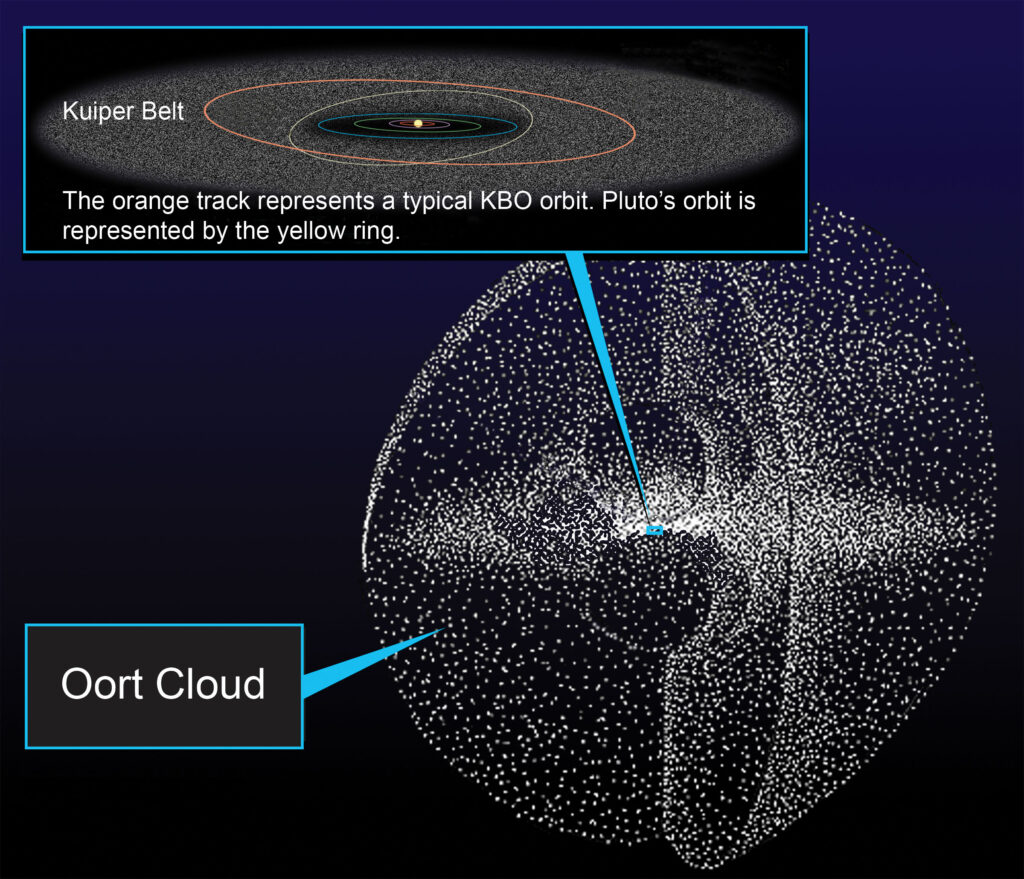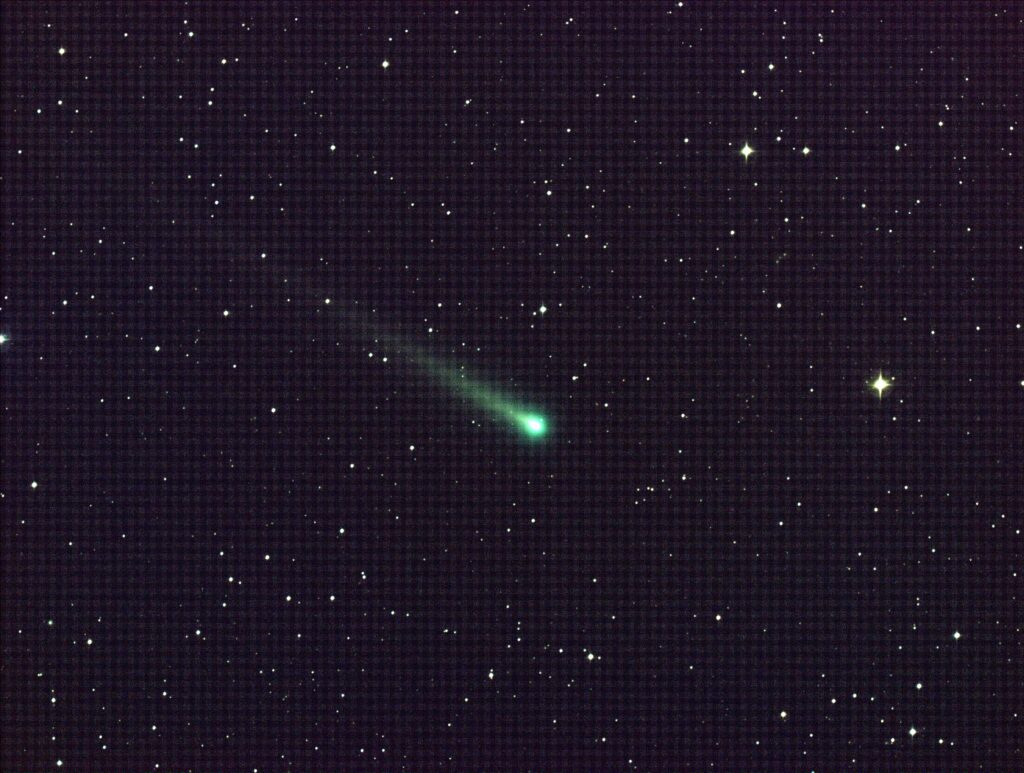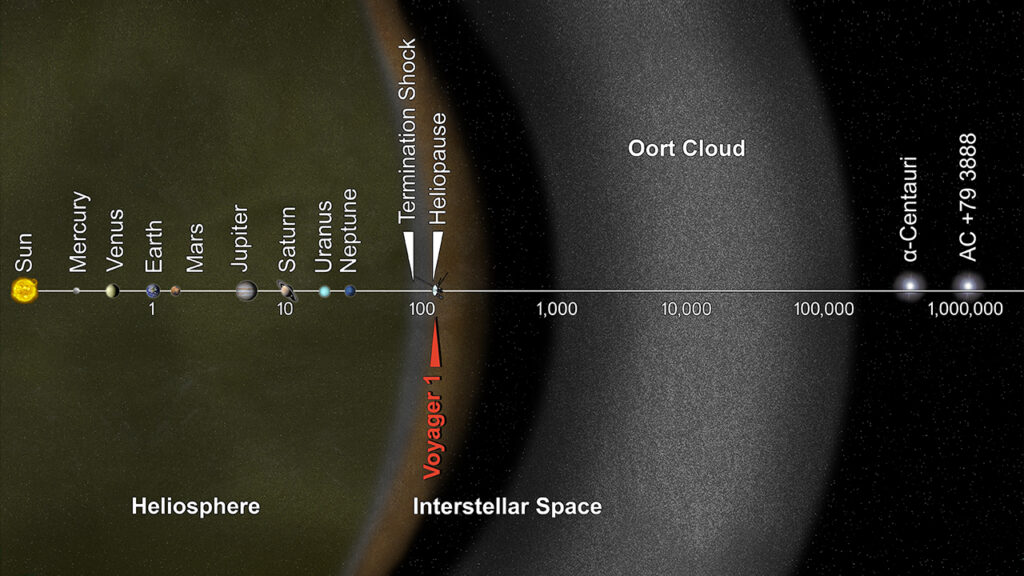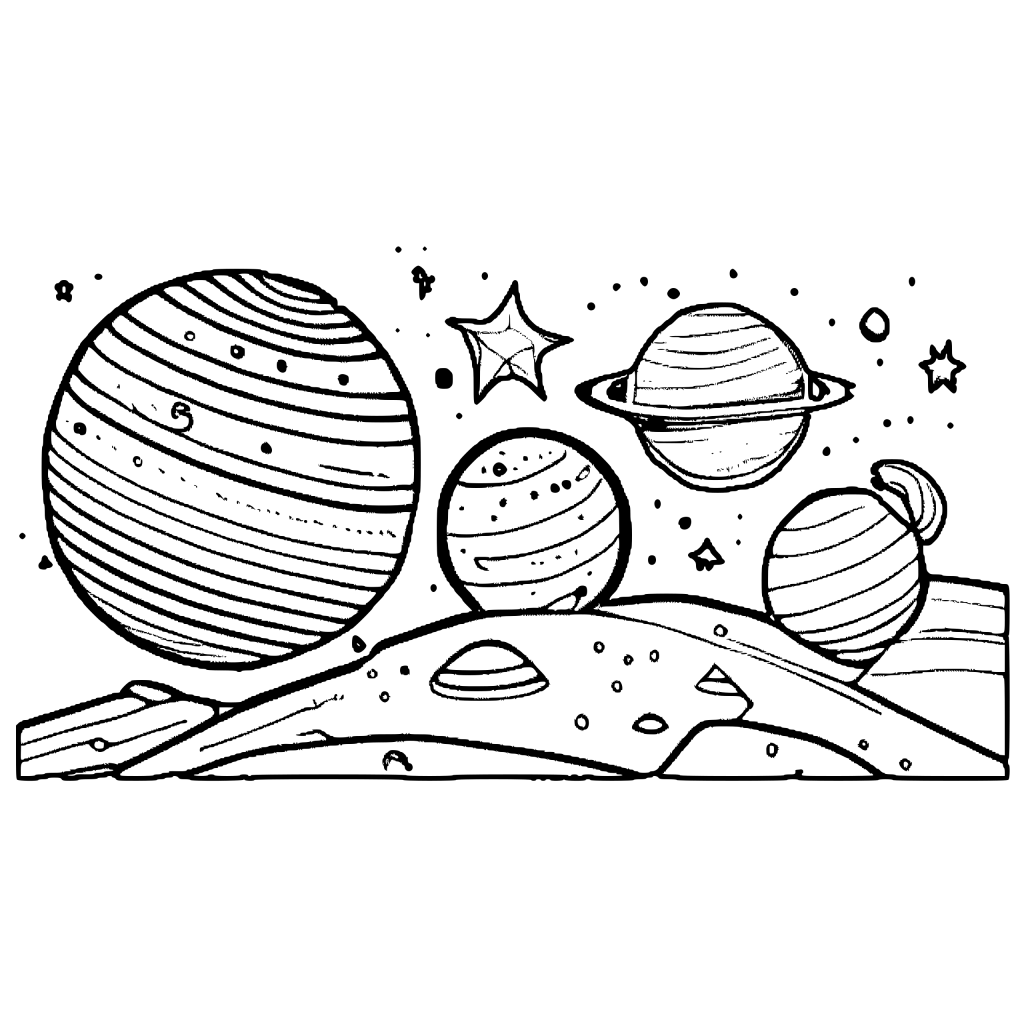Home of Long-Period Comets
© ESO/L. Calçada
Nestled in the distant periphery of our solar system, the Oort Cloud extends beyond the recognizable planets and the frosty domain of the Kuiper Belt. Named after the Dutch astronomer Jan Oort, who postulated its existence in the 1950s, this celestial wonderland is a vast and enigmatic repository of countless icy bodies and comets. The Cloud is a testament to the enduring mysteries of the cosmos and plays a pivotal role in our understanding of the solar system’s history and dynamics.
The Oort Cloud exists in the realm of theoretical possibility and observation. Unlike the Kuiper Belt, which comprises relatively well-known objects like Pluto and Eris, the Oort Cloud is an immense and distant reservoir that is believed to extend to the outermost reaches of the Sun‘s gravitational influence. Within its icy depths may lurk remnants from the solar system’s birth, offering clues to the conditions that prevailed during those ancient eons.
FORMATION

The formation of the Cloud, a distant and enigmatic region on the outskirts of our solar system, remains a subject of theoretical exploration due to the limited direct observations of this region. However, scientists have developed several hypotheses and theories to explain the formation of the Oort Cloud.
SOLAR SYSTEM’S EARLY DYNAMICS
The Oort Cloud is thought to have formed during the early stages of the solar system’s evolution, approximately 4.6 billion years ago. At this time, the young sun was surrounded by a vast cloud of gas and dust, the remnants of which eventually merged to form the planets.
GRAVITATIONAL PERTURBATION
During the solar system’s infancy, the gravitational influence of neighbouring stars, passing molecular clouds, or galactic tidal forces could have perturbed the orbits of small icy objects in the outer regions of the solar system.
SCATTERING BY GIANT PLANETS
The gravitational influence of the giant planets, particularly Jupiter and Saturn, may have played a significant role in the formation of the Oort Cloud. As these giant planets migrated in the early solar system, their gravitational interactions with smaller objects could have sent some of them into the distant reaches, forming the outer shell of the Cloud.
CAPTURE OF INTERSTELLAR OBJECTS
Some theories suggest that the Oort Cloud may have captured objects from interstellar space—comets and icy bodies that were not originally part of our solar system. These captured objects then became part of the Cloud population.
EJECTION OF OBJECTS
Occasionally, gravitational interactions within the solar system may have ejected objects from the inner regions to the outer reaches, where they became part of the Oort Cloud.
ICY OBJECT AGGREGATION
Another theory proposes that the Oort Cloud formed through the gradual accumulation of icy objects over time. These objects, originating in the distant solar system, may have been gravitationally bound into a vast cloud of comets.
SIZE AND MASS

Determining the size and mass of the Oort Cloud is challenging due to its theoretical and distant nature. The Cloud is believed to be a vast and largely uncharted region on the outskirts of the solar system, consisting of countless icy bodies and comets.
SIZE
- Inner Oort Cloud: The inner boundary of the Oort Cloud is estimated to be around 2,000 astronomical units (AU) from the Sun. One AU is the average distance from Earth to the Sun, approximately 93 million miles (150 million kilometers).
- Outer Oort Cloud: The outer boundary of the Oort Cloud is believed to extend much farther, possibly up to 50,000 AU or more from the Sun. This outer region is characterized by extremely distant and elongated orbits of its icy objects.
- Spherical Distribution: The Oort Cloud’s size is often depicted as a spherical distribution of objects. However, the actual distribution and density of objects within the cloud may not be uniform due to gravitational perturbations from nearby stars and the Milky Way‘s gravitational influence.
MASS
Determining the total mass of the Oort Cloud is even more challenging than measuring its size, primarily because many of its objects are small and faint, and they are located at extreme distances from the Sun. As a result, mass estimates are highly uncertain and are typically based on theoretical models and assumptions.
- Low Individual Mass: Most objects within the Oort Cloud, including comets and icy bodies, are relatively small and have low individual masses. They typically range from a few kilometers to a few tens of kilometers in size.
- Population Size: The total number of objects within the Oort Cloud is believed to be vast, possibly numbering in the trillions. However, because of their small size, their collective mass remains uncertain.
- Uncertainty: Mass estimates for the Oort Cloud can vary widely in scientific literature. Some estimates suggest that the combined mass of the Cloud objects may be on the order of Earth‘s mass, while others propose higher or lower values.
- Interstellar Objects: Some theories propose that the Oort Cloud may also contain objects captured from interstellar space, further complicating mass estimations.
OORT CLOUD OBJECTS

The Oort Cloud is a hypothetical region located at the outermost reaches of our solar system, and it is believed to be populated by a diverse array of celestial objects, primarily comets and icy bodies.
COMETS
Comets are the most well-known and prominent members of the Oort Cloud. These objects consist of a solid nucleus composed of ice, dust, and various organic compounds. When comets approach the Sun, the heat causes the ice to vaporize, forming a glowing coma (a cloud of gas and dust) and often producing a spectacular tail that points away from the Sun. Comets from the Cloud periodically enter the inner solar system, becoming visible from Earth. They come in two main categories:
LONG-PERIOD COMETS
These comets have orbits that can take them thousands to millions of years to complete. They originate from the distant reaches of the Oort Cloud and are typically the ones that make infrequent appearances in the inner solar system.
SHORT-PERIOD COMETS
Some comets, known as short-period comets, have orbits that bring them back into the inner solar system more frequently. These comets are believed to originate from the Kuiper Belt, a region closer to the Sun than the Oort Cloud.
ICY BODIES
In addition to comets, the Oort Cloud likely contains a multitude of smaller icy bodies. These bodies can range in size from a few kilometers to tens of kilometers or more. While they may not be as well-known as comets, they contribute to the overall population of the Cloud and may occasionally become active as comets when they approach the Sun.
INTERSTELLAR OBJECTS
Some theories suggest that the Oort Cloud may also contain objects captured from interstellar space. These objects, if present, would be exotic and potentially distinct from the solar system’s native icy bodies.
DISTANT AND ELONGATED ORBITS
Oort Cloud Objects are characterized by their extremely distant and elongated orbits. They spend most of their existence in the frigid depths of the outer solar system, far from the warmth of the Sun.
ROLE IN SOLAR SYSTEM DYNAMICS

The Oort Cloud plays a significant and intriguing role in the dynamics of our solar system. Despite being a theoretical and mostly uncharted region, it exerts influence on the inner solar system and contributes to various aspects of the solar system’s dynamics.
COMET RESERVOIR
The Oort Cloud is considered the primary source of long-period comets, which are comets with orbits that take them thousands to millions of years to complete. These comets originate in the distant reaches of the Cloud. When perturbed by gravitational interactions, such as those with passing stars or the Milky Way‘s gravitational field, some Oort Cloud Objects are nudged into trajectories that bring them closer to the Sun. As they approach the inner solar system, they become visible as comets. The Oort Cloud, therefore, serves as a reservoir of comets that periodically enter the inner solar system, providing a source of these celestial visitors.
OUTER SOLAR SYSTEM DYNAMICS
The gravitational influence of the Oort Cloud extends far beyond its boundaries. It exerts a subtle yet pervasive influence on the outer solar system, including the orbits of distant planets like Neptune. Gravitational interactions between the outer planets and Oort Cloud Objects can lead to the scattering of comets and other objects into different orbits. This dynamic interaction can influence the overall stability and structure of the outer solar system.
LONG-TERM STABILITY
The presence of the Oort Cloud helps to stabilize the overall structure of the solar system over very long time scales. Objects in the Cloud act as a gravitational buffer, absorbing and redistributing energy from perturbing forces. This helps maintain the relative stability of the inner planets’ orbits over billions of years.
GALACTIC PERTURBATIONS
The Milky Way‘s gravitational field and encounters with nearby stars can perturb Oort Cloud Objects, altering their orbits and sending some of them into the inner solar system. These galactic perturbations contribute to the periodicity and unpredictability of comet appearances in the night sky.
THE SEARCH FOR LIFE

The Oort Cloud, though primarily composed of icy objects and comets, has indirect implications for the search for life in our solar system and beyond. While it may not be a direct location for astrobiology, it plays a role in the broader context of understanding the potential for life in the universe.
COMETARY DELIVERY OF ORGANIC COMPOUNDS
Comets originating from the Oort Cloud have the potential to carry organic compounds and water ice. These compounds, including amino acids and complex organic molecules, are essential building blocks of life as we know it. When comets collide with planets or deliver their materials to planetary bodies, they may contribute to the inventory of organic compounds on those worlds. This could be especially relevant for celestial bodies within our solar system, such as Europa and Enceladus, where subsurface oceans might harbour life.
IMPACTS AND PLANETARY HABITABILITY
The Oort Cloud is the source of long-period comets, some of which can have highly elliptical and unpredictable orbits. While these comets are not a direct threat to life on Earth, their impacts have played a role in shaping the planet’s history. Some scientists hypothesize that comet impacts may have delivered water and organic molecules to Earth during its early history, potentially contributing to the conditions conducive to life’s emergence.
GALACTIC CONTEXT
The existence and dynamics of the Oort Cloud are influenced by the gravitational interactions of nearby stars and the Milky Way‘s gravitational field. Understanding these interactions provides insights into the broader galactic context in which our solar system exists. This context can be relevant when considering the potential distribution of habitable zones and environments in the galaxy.
OORT CLOUD AND HYPOTHETICAL PLANET NINE
Some theories suggest that the Oort Cloud’s dynamics could be influenced by the presence of a massive, as-yet-undiscovered planet known as Planet Nine. This hypothetical planet’s interactions with the Oort Cloud may affect the distribution of comets and icy bodies. Understanding these interactions could have implications for the long-term stability of habitable zones in the solar system.
ASTROBIOLOGY BEYOND THE SOLAR SYSTEM
When considering the broader field of astrobiology and the search for life beyond our solar system, the study of the Oort Cloud offers insights into the potential distribution of comets and icy bodies around other stars. This has implications for understanding the potential transport of organic materials and water between star systems, which could be relevant for exoplanetary systems.
Learn about “Kuiper Belt vs Oort Cloud“
